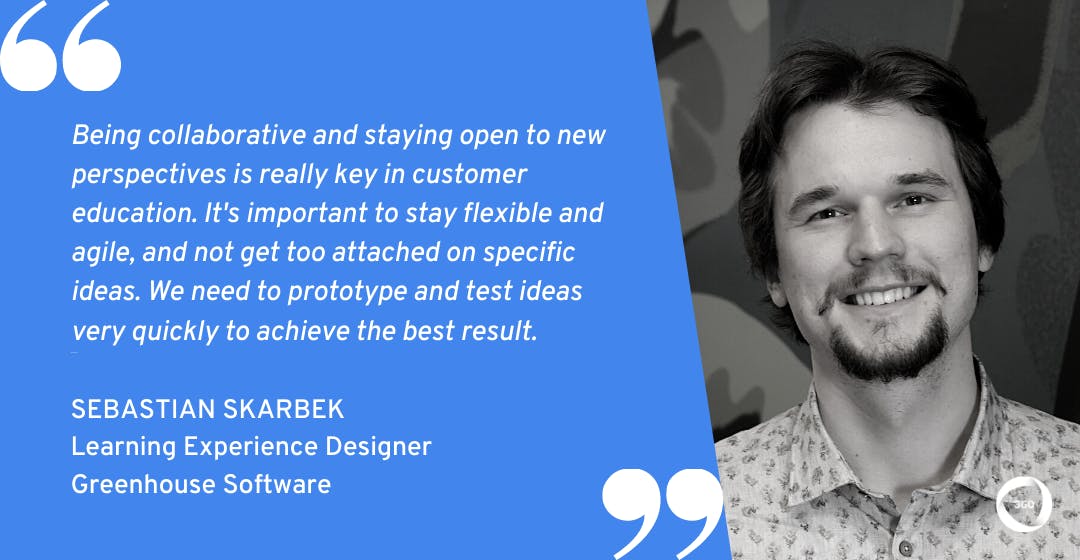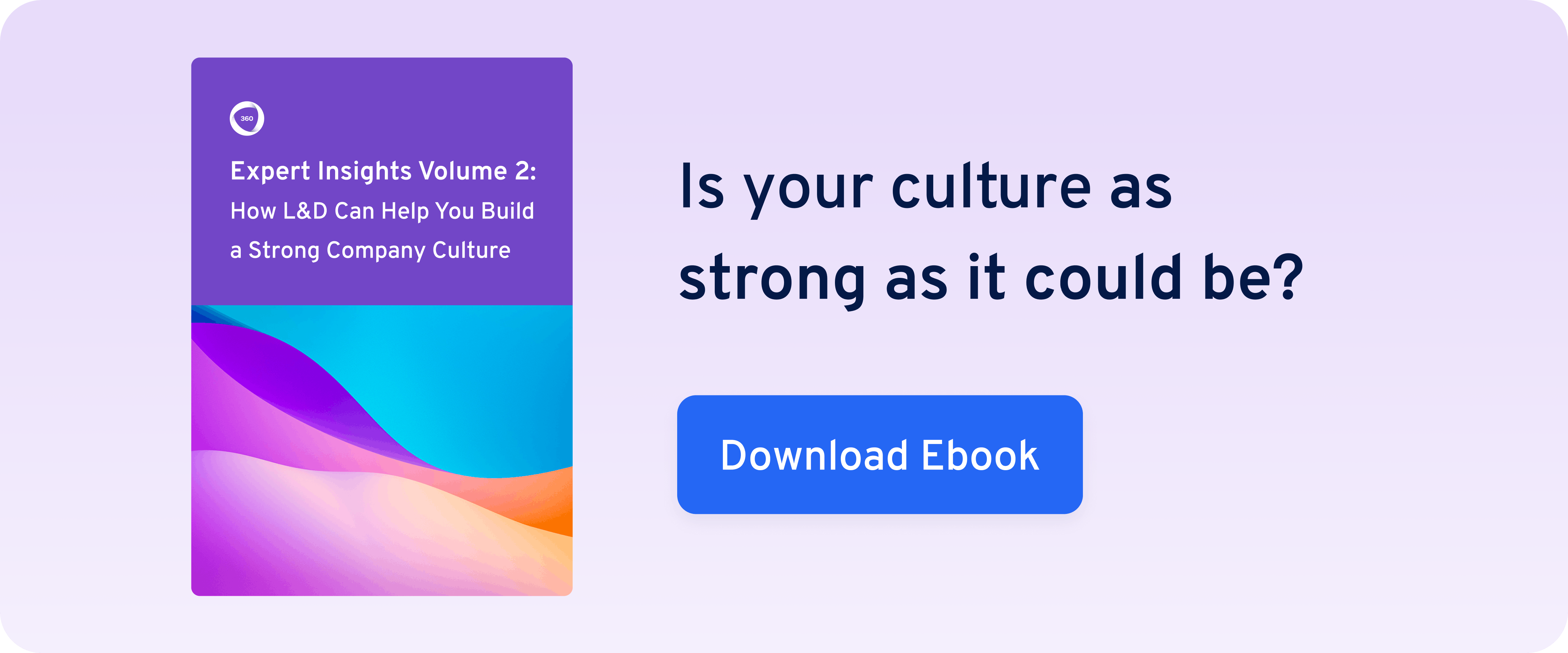Consistent company communication is always key. But in customer education, it’s make-or-break. Your clients deserve a smooth experience: no matter who they’re talking to, they need access to dependable, clear, and reliable information about your product.
This really raises the bar for team collaboration when delivering customer education programs–especially in fast-growing companies. So, how can you ship consistently great content, even as your product is evolving and you’re growing into new customer segments?
That’s exactly what I wanted to discuss with Sebastian Skarbek, Learning Experience Designer at Greenhouse Software. Sebastian was kind enough to let me in on his three-step collaboration playbook for delivering great customer education programs between teams.
We kicked off our discussion with a challenge many companies are facing right now: staying consistent while scaling.
The challenge of staying consistent while scaling
As Sebastian explains, Greenhouse Software is growing a lot right now, giving rise to a new set of challenges for customer education and support.
“At Greenhouse, the main ongoing challenge we have is that we’re growing very quickly in terms of the number of customers we’re working with, as well as the number of hires we’re bringing in to support those customers,” he says. “Within our Customer Education team, we’re focusing on supporting that growth with scalable content solutions.”
“First, we want to make it as easy as possible to onboard and support customers. Then, we want to decrease the time it takes for them to unlock the value of the platform, which improves the customer experience and shows them what we can do straight away.”
For Sebastian and the other customer support teams, the toughest part came right at the starting block. “The main challenge we faced as a relatively new program or specialized team was in getting started. We had to find a way to meet our foundational content requirements to address key learning needs for our different types of users participating in our platform.”
“We also had to create content to match the immediate needs identified by our customer success teams, which were coming through from customer feedback and industry trends. We had to cover as much of this ground as we could, all while staying consistent.”
So, how is Sebastian meeting these challenges within Greenhouse’s customer education programs?
Related: Klaviyo’s 3 Steps for Driving 85%+ NPS for New Hire Enablement
We want to decrease the time it takes for our customers to unlock the value of the platform, which improves the customer experience and shows them what we can do straight away.
You can never have enough expert insights! Check out our ebook to find out How L&D Can Help You Build a Strong Company Culture
How Greenhouse collaborates to create great customer education programs in 3 steps
As Sebastian explains, to deliver consistently great customer education programs while scaling, he needed to collaborate through three key steps.
“As we were getting started, we realized that creating a scalable method of content creation would depend on three key factors. Firstly, we needed to improve the way we worked with others, and use our collaboration between teams as a source of strength. Rather than getting in each other’s way, we focused on how different teams could help each other out.”
“The second component comes out of our content creation strategy,” says Sebastian. “This was about starting with a clear outline, getting more tactical and agile, and looking for ways to repurpose existing content to achieve the outcomes we were focused on.”
“Finally, we needed to stay flexible throughout the whole process. This meant remaining open to new ideas and suggestions, and not getting hung up on specific ideas too early.”
Here’s what this three-step collaboration playbook looks like in practice at Greenhouse Software.
1. Partnering with Customer Marketing to develop content
“Since we were a new team, we needed to start by getting very precise about our vision and our role,” says Sebastian. “We got this type of clarity about how we fit into the current content ecosystem by asking a few key questions.”
“What is our mandate as the Customer Education team? What are we trying to achieve? Which content delivery vehicles would help make that vision possible? We asked the same type of questions about the other content teams operating in our space.”
This process soon revealed the right team partner. “As we carried out this analysis, we stressed similarities and the points of strength. As a result, we found a natural partner in our Customer Marketing team. Their mandate is to establish best practices, guidance, and solutions for our customers through webinars, guides, and case studies.”
As Sebastian explains, this partnership allowed each team to focus on their own particular style of communication and customer support. “As the Customer Education team, we develop tactical applications of best practices for using the platform. Our natural content vehicles are eLearning courses and videos.”
“Our Customer Marketing team is a little bit more aspirational about showing what’s possible, whereas Customer Education needs to be more direct in highlighting and explaining specific steps within the platform. It’s not a 50/50 exclusive split, and there’s a good amount of overlap. That’s why it was so important to develop a shared content creation strategy.”
Related: Experts Engagement Tool: Leverage Subject-Matter Expertise with Collaborative Learning
Our Customer Marketing team is a little bit more aspirational about showing what’s possible, whereas Customer Education needs to be more direct in highlighting and explaining specific steps within the platform.
2. Aligning on a high-level content outline first
To get started with this content creation strategy, Sebastian and his team needed to start with a high-level content outline and work from there.
“Since we’re both working on many of the same things–getting those best practices out there and making things more accessible to customers–we found that working from a joint high-level outline for those themes was the best first step for us.”
“By aligning early, we found points that needed further clarification. It was fully collaborative: we’d fill out the content outline with what we know, the resources at our disposal, and once we had that clear central picture, we could get specific. We then developed outlines that followed from the master document, based on those centralized themes and resources.”
For Sebastian, this approach gave the right mixture of autonomy and consistency. “The separate teams would own those outlines, but they’re still organized in one central place. Let’s say I’m working on the outline for a course. I can jump into an outline for a webinar for Customer Marketing, and perhaps pull some useful information there, then cross-reference our material. I know they’re doing the same, and it helps us to bring the right level of consistency.”
3. Staying flexible throughout the collaboration
Finally, Sebastian knew that staying flexible was the key to a successful customer education collaboration.
“Being collaborative and staying open to new perspectives is really key in customer education. It’s important to stay flexible and agile, and not get too attached to specific ideas. We need to prototype and test ideas very quickly to achieve the best result.”

“In practice, this can get a bit messy. So it’s also crucial to be organized. I rely heavily on my ability to take abstract concepts and ideas and present them in a clear way to the folks I’m collaborating with. This could be in a course outline like the ones we’ve talked about, or it could be in a diagram or a visual.”
This three-step collaboration showcases a number of key Collaborative Learning practices: bringing stakeholders on board, developing the right methodology to keep exchanges organized and transparent, and assigning clear roles and responsibilities to avoid confusion.
Related: How to Create an Effective Collaborative Learning Environment
The impact of Greenhouse’s new customer education programs
So, that’s an overview of Sebastian’s three-step collaboration playbook. But what impact is he seeing as a result?
“Over the past year, we’ve been doing a lot to experiment and fine-tune our collaboration process,” says Sebastian. “We’ve launched a variety of learning courses to address some needs that came up specifically for remote hiring during COVID-19. We also have a large number of exciting releases coming up this quarter.”
As Sebastian explains, this process of experimentation has created three key benefits for Greenhouse’s customer education programs: greater continuity, consistent quality, and closer strategic alignment.
1. Greater continuity
“The key benefits we’re seeing so far is that we have greater continuity in our approach, and consistent messaging. If we’re using a five-point framework in Customer Education to describe something to a client, I know that Customer Marketing will be working from the same material.”
2. Consistent quality
“Another effect we’re seeing is in the quality of our materials. Having an additional peer review at every stage really helps. I still validate my content with our subject-matter experts, but getting alignment and diverse perspectives early on makes it a lot smoother for everybody.”
3. Strategic alignment
“The third thing is that we’re able to confidently map our efforts to company-wide goals and initiatives, because of our first alignment based on our strategic goals. It’s a great way to ensure a clear and consistent mandate for any learning needs we’re addressing.”
We’re able to confidently map our efforts to company-wide goals and initiatives, because of our first alignment based on our strategic goals. It’s a great way to ensure a clear and consistent mandate for any learning needs we’re addressing.
Thanks again to Sebastian for sharing his story!
While you’re here, check out my expert interviews with Alessia Di lacovo of Too Good To Go on supporting key account managers with tailored growth paths, and Ta Lynn Mitchell of Code Nation about her four steps to support volunteer teachers with Collaborative Learning.
Want more peer insights on transforming workplace learning? Check out #CLOConnect, our interview series with top L&D leaders on driving growth and scaling culture through Collaborative Learning. Or you can subscribe (below 👇) to our weekly newsletter to receive our latest posts directly in your inbox.



